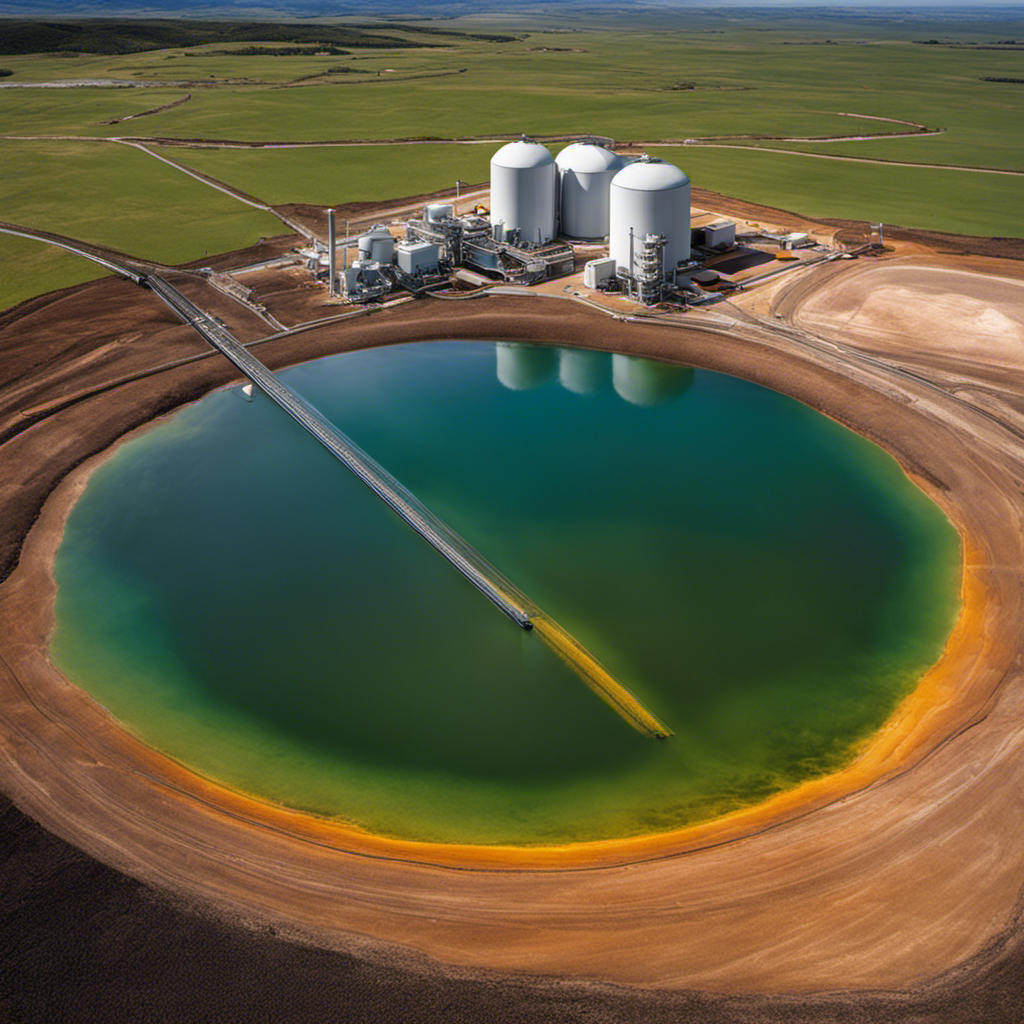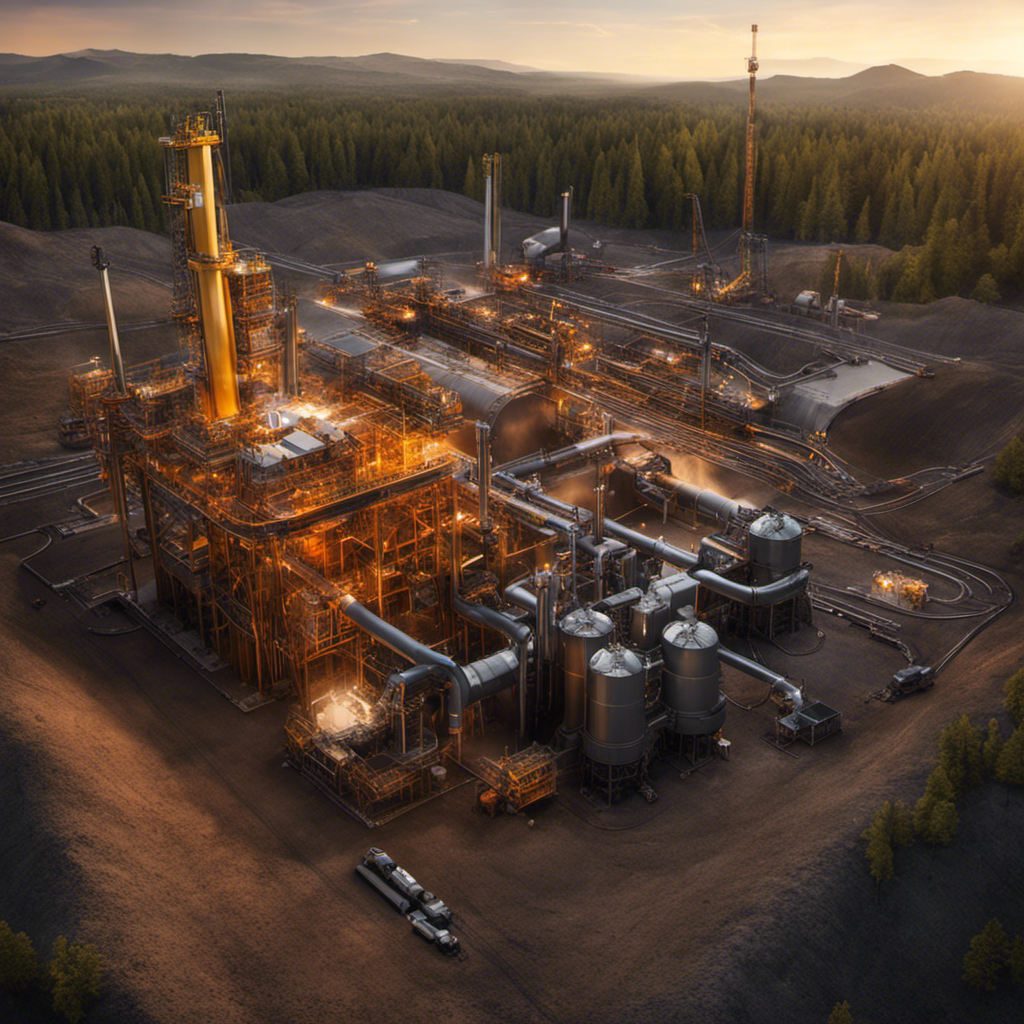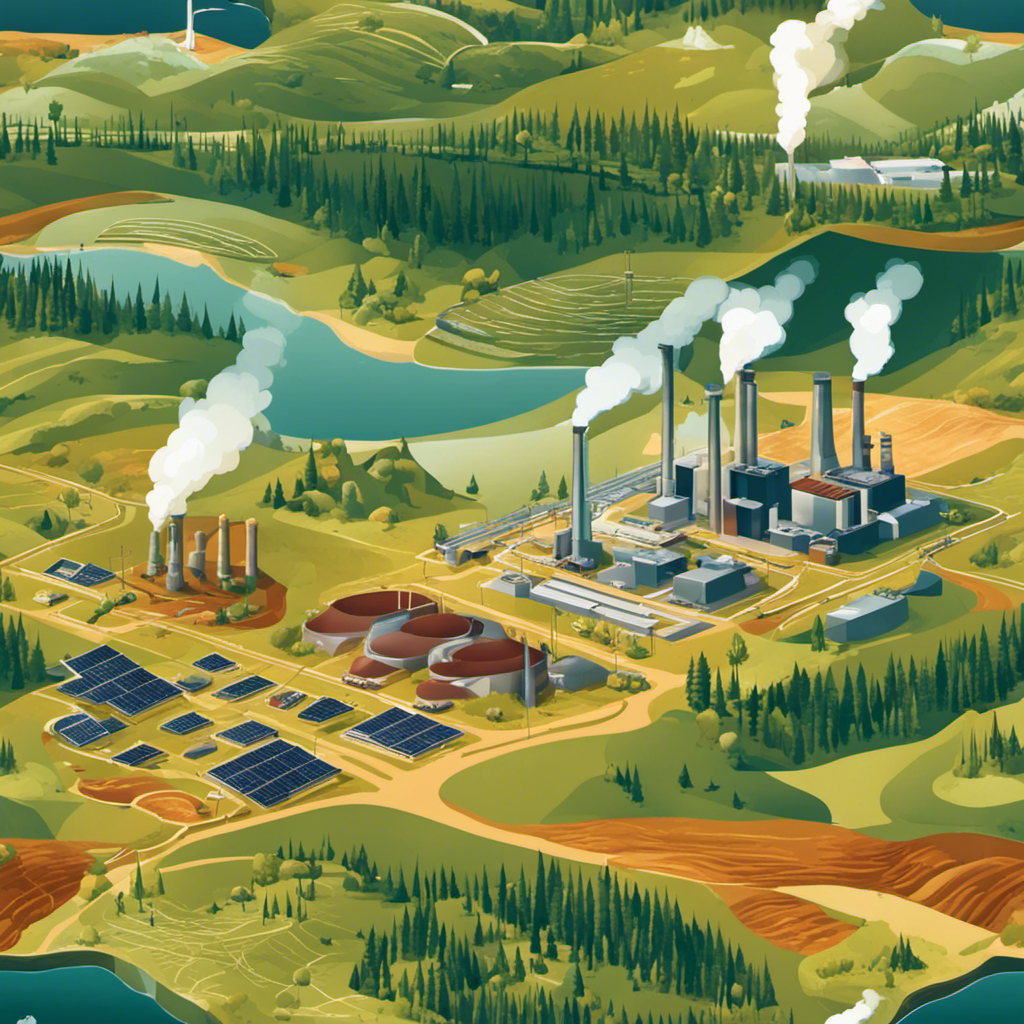Geothermal
Which State Generates The Most Geothermal Energy And Why

Did you know that there is one state in the United States that is the top producer of geothermal energy in the country? This state actually produces more geothermal energy than any other state.
But what makes this state so successful in harnessing this renewable energy source? In this article, I will explore the factors driving geothermal energy production and reveal the state that takes the top spot.
Join me as we delve into the world of geothermal energy and uncover the secrets behind this state’s impressive achievements.
Key Takeaways
- California leads the nation in geothermal energy production.
- Abundant geothermal resources in California contribute to its success.
- California has implemented policies and regulations that encourage geothermal energy projects.
- Tax incentives and streamlined permitting processes attract investment in the sector.
Geothermal Energy: An Overview
I find geothermal energy fascinating because it harnesses heat from beneath the Earth’s surface to generate electricity.
Geothermal energy has several advantages. First, it’s a renewable energy source that doesn’t rely on fossil fuels, reducing carbon emissions and air pollution. Second, geothermal power plants have a small land footprint compared to other energy sources, making them suitable for urban areas. Additionally, geothermal energy is reliable and available 24/7, providing a stable and consistent power supply.
However, there are also some disadvantages to consider. Geothermal power plants can only be built in specific locations with high heat underground, limiting their widespread use. Furthermore, the initial investment for geothermal energy technology can be high, although operational costs are relatively low.
Despite these challenges, advancements in geothermal technology, such as enhanced geothermal systems and binary cycle power plants, are making it a more viable and competitive option for clean energy production.
Ranking the Top Geothermal Energy Producing States
California leads the nation in geothermal energy production due to its abundant geothermal resources and favorable regulatory environment.
The state’s geothermal energy production trends have been consistently increasing over the years, making it a major player in the renewable energy sector. With its vast geothermal resources, California has the potential to further expand its geothermal energy production in the future.
Here are two reasons why California is at the forefront of geothermal energy production:
-
Abundant Geothermal Resources: California is located along the Pacific Ring of Fire, a region known for its high geothermal potential. The state has numerous active geothermal fields and hot springs, which provide a reliable source of renewable energy.
-
Favorable Regulatory Environment: California has implemented policies and regulations that encourage the development of geothermal energy projects. These include tax incentives, feed-in tariffs, and streamlined permitting processes, all of which attract investment and promote the growth of the geothermal energy sector.
Considering these factors, California’s geothermal energy production is expected to continue thriving and contribute significantly to the state’s renewable energy goals in the future.
The Leader: Which State Generates the Most Geothermal Energy
As for geothermal energy production, it is interesting to note that the state leading in this sector has an abundant resource base and a favorable regulatory environment. California is currently the top producer of geothermal energy in the United States, generating over 3,900 megawatts of electricity from this renewable source. This success can be attributed to California’s geothermal resource potential, with its numerous geothermal fields and hotspots. Additionally, the state has implemented policies and regulations that encourage the development of geothermal projects, such as streamlined permitting processes and financial incentives. However, despite the growth of the geothermal energy industry, there are still challenges to overcome in geothermal energy production, including high upfront costs, the need for advanced drilling technologies, and potential environmental impacts. Nevertheless, the potential for further growth in the geothermal energy sector is promising, given the increasing demand for renewable energy sources and the advancements in geothermal technology.
| State | Geothermal Capacity (MW) |
|---|---|
| California | 3,900 |
| Nevada | 776 |
| Utah | 128 |
Transitioning into the subsequent section about factors driving geothermal energy production, it is important to understand the key drivers that have contributed to California’s success in this sector.
Factors Driving Geothermal Energy Production
Transitioning into the subsequent section about factors driving geothermal energy production, it’s important to consider the key factors that have contributed to the success of this renewable energy source.
-
Natural Resources
-
Abundant geothermal resources, such as hot springs and geysers, provide a reliable and constant heat source for energy production.
-
High temperature gradients in certain regions allow for more efficient geothermal power generation.
-
Environmental Benefits
-
Geothermal energy production emits minimal greenhouse gases, reducing the carbon footprint and mitigating climate change.
-
This renewable energy source doesn’t rely on fossil fuels, eliminating the risks associated with fuel extraction and transportation.
These factors driving geothermal energy production have led to its increasing popularity and adoption. The abundance of natural resources and the environmental benefits make geothermal energy a sustainable and attractive choice for meeting our energy needs.
Environmental and Economic Benefits of Geothermal Energy
In my opinion, one of the major advantages of geothermal energy is its positive impact on both the environment and the economy.
Geothermal energy for residential use has gained popularity due to its numerous benefits. It’s a clean and renewable energy source that produces minimal greenhouse gas emissions, reducing our carbon footprint.
Additionally, geothermal energy is cost-effective in the long run, as it requires little maintenance and has low operating costs.
Developing countries can greatly benefit from geothermal energy as it provides a reliable and sustainable source of power, reducing their dependence on fossil fuels and expensive imports. Furthermore, the development of geothermal resources in these countries can create job opportunities and stimulate economic growth.
Overall, geothermal energy offers a promising solution for both environmental sustainability and economic development.
Frequently Asked Questions
How Does Geothermal Energy Compare to Other Renewable Energy Sources in Terms of Cost and Efficiency?
Geothermal energy is cost-effective and efficient compared to other renewable sources. It provides a stable and reliable energy supply, with low operating costs and high capacity factors. Additionally, geothermal energy has a small environmental footprint and can be utilized 24/7.
What Are the Potential Drawbacks or Challenges Associated With Geothermal Energy Production?
Potential drawbacks and challenges associated with geothermal energy production include high upfront costs, limited suitable locations, and the risk of releasing harmful gases. However, solutions such as advanced drilling techniques and improved resource assessment can mitigate these challenges.
Are There Any Specific Policies or Incentives That Have Contributed to the High Geothermal Energy Production in the Leading State?
There are specific policies and incentives that have contributed to the high geothermal energy production in the leading state. For example, tax credits and grants have encouraged investment in geothermal projects, driving growth in the industry.
How Does the Geology or Geographical Characteristics of the Leading State Contribute to Its High Geothermal Energy Generation?
The geology and geographical characteristics of the leading state play a significant role in its high geothermal energy generation. These factors provide an abundant source of heat from the earth’s core, making it ideal for harnessing geothermal power.
What Are Some Innovative Technologies or Advancements in Geothermal Energy Production That Could Further Enhance the Potential of This Renewable Energy Source?
Innovative technologies and advancements in geothermal energy production have the potential to greatly enhance the efficiency and sustainability of this renewable energy source. These advancements can lead to increased geothermal energy production and further contribute to reducing our reliance on fossil fuels.
Conclusion
After conducting extensive research and analyzing the data, it’s clear that California stands as the undisputed leader in geothermal energy production.
The state’s abundance of geothermal resources, coupled with supportive policies and investments, have propelled it to the top.
With its commitment to renewable energy, California serves as a shining example of how harnessing geothermal energy can bring about both environmental and economic benefits.
It’s truly awe-inspiring to witness the transformative power of geothermal energy in action.
Geothermal
How Is Geothermal Energy Captures

As I explore deep into the Earth’s crust, I am amazed by the immense potential of geothermal energy. Like a source of power ready to be utilized, this sustainable resource provides a green solution to our energy requirements.
By utilizing heat transfer fluids and extracting heat from geothermal reservoirs, we can convert this natural heat into usable energy.
Join me on a journey as we explore how geothermal energy is captured and transformed, unlocking a world of clean and limitless power.
Key Takeaways
- Underground drilling techniques, such as directional drilling and hydraulic fracturing, are essential for accessing geothermal energy.
- Understanding the geothermal gradient is crucial for identifying areas with high heat flow and geothermal reservoirs.
- Heat transfer fluids play a crucial role in efficiently extracting thermal energy from underground reservoirs.
- Geothermal power plants and heating systems are the main applications for extracting heat from geothermal reservoirs, reducing greenhouse gas emissions and diversifying energy sources.
Drilling Into the Earth’s Crust
I can feel the intense heat as I drill deeper into the Earth’s crust for geothermal energy.
Underground drilling techniques play a crucial role in harnessing geothermal power generation. These techniques involve drilling deep into the Earth’s crust to access the natural heat trapped beneath the surface.
One commonly used method is known as directional drilling, which allows for drilling at various angles and depths. This technique maximizes the extraction of geothermal resources by reaching the hottest areas of the Earth’s crust.
Another technique is known as hydraulic fracturing, where water is injected into the rock formations to create fractures and improve the flow of geothermal fluids.
These underground drilling techniques are essential in tapping into the Earth’s natural heat and converting it into a sustainable source of energy.
Understanding the Geothermal Gradient
The temperature beneath the Earth’s surface increases as you go deeper, which is why understanding the geothermal gradient is crucial.
Geothermal gradient exploration involves studying the changes in temperature with depth to determine the potential for harnessing geothermal energy. This exploration helps identify areas with high heat flow, indicating the presence of geothermal reservoirs.
Heat exchange mechanisms play a significant role in the geothermal gradient. Conduction is the primary mechanism responsible for the increase in temperature with depth. As heat is conducted from the Earth’s core towards the surface, it creates the geothermal gradient.
Convection also plays a role, especially in areas with active volcanic activity, where hot fluids rise towards the surface.
Utilizing Heat Transfer Fluids
Utilizing heat transfer fluids allows for efficient extraction of thermal energy from underground reservoirs. Heat transfer fluids play a crucial role in geothermal energy systems by transferring heat from the reservoir to the surface, where it can be utilized for various purposes.
One of the benefits of using heat transfer fluids is their excellent heat transfer properties, which enable them to efficiently capture and transport thermal energy. These fluids are capable of withstanding high temperatures and pressures, making them suitable for geothermal applications. However, there are also challenges in using heat transfer fluids. They must be carefully selected to ensure compatibility with the geothermal reservoir and equipment. Additionally, the potential for fluid leakage and environmental impacts must be addressed.
Despite these challenges, heat transfer fluids are essential for harnessing the immense energy potential of geothermal reservoirs.
Transitioning into the subsequent section about extracting heat from geothermal reservoirs, it’s important to understand the different methods and technologies involved in this process.
Extracting Heat From Geothermal Reservoirs
Extracting heat from underground reservoirs involves the use of various methods and technologies to harness the immense thermal energy potential.
Geothermal power plants and geothermal heating systems are two main applications of this process.
Geothermal power plants utilize the heat stored in the Earth’s crust to generate electricity. They use wells to extract hot water or steam from deep underground, which then drives turbines to produce power.
On the other hand, geothermal heating systems use heat pumps to transfer heat from the ground to heat buildings or provide hot water. These systems rely on the stable temperature of the Earth’s crust to provide efficient and sustainable heating solutions.
Both geothermal power plants and heating systems play a crucial role in reducing greenhouse gas emissions and diversifying our energy sources.
Converting Heat Into Usable Energy
I can convert heat from underground reservoirs into usable energy through various methods and technologies. One of the key ways to harness this heat is through the use of geothermal power plants.
These plants utilize heat exchangers to transfer the heat from the reservoirs to a working fluid, typically water or steam. The heat causes the working fluid to expand and turn into steam, which then drives a turbine to generate electricity.
This process is highly efficient and has a minimal environmental impact compared to traditional fossil fuel power plants. In fact, geothermal power plants can produce electricity with a capacity factor of up to 90%, meaning they can operate at full power for up to 90% of the time.
This reliability and sustainability make geothermal power a promising option for meeting our energy needs.
Frequently Asked Questions
How Deep Do Geothermal Wells Need to Be Drilled to Access the Earth’s Heat?
To access the earth’s heat for geothermal energy, drilling depth is typically between 1,500 to 10,000 feet. This depth allows for efficient heat extraction from the earth’s hot rocks and water reservoirs.
What Factors Affect the Efficiency of Heat Transfer Fluids in Geothermal Energy Systems?
Factors such as fluid type, flow rate, and temperature difference can affect the efficiency of heat transfer in geothermal energy systems. Analyzing data on these variables can help optimize the efficiency of geothermal energy capture.
Are There Any Environmental Concerns or Risks Associated With Extracting Heat From Geothermal Reservoirs?
There are environmental concerns associated with extracting heat from geothermal reservoirs, such as the release of greenhouse gases and the potential for induced seismic activity. However, mitigation strategies can minimize these impacts and make geothermal energy a more sustainable option.
How Is the Heat Converted Into Usable Energy in Geothermal Power Plants?
The heat conversion process in geothermal power generation is fascinating. By tapping into the Earth’s natural heat, it is converted into usable energy. It’s incredible how we can harness this power for sustainable electricity.
Are There Any Limitations or Potential Challenges in Harnessing Geothermal Energy on a Large Scale?
There are several limitations and challenges in harnessing geothermal energy on a large scale. These include the need for suitable geological conditions, high upfront costs, and potential environmental concerns such as groundwater contamination and seismic activity.
Conclusion
In conclusion, geothermal energy is harnessed by drilling into the Earth’s crust and extracting heat from geothermal reservoirs. Utilizing heat transfer fluids and understanding the geothermal gradient, we’re able to convert this heat into usable energy.
As the saying goes, ‘Where there’s heat, there’s power.’ With its sustainable and renewable nature, geothermal energy holds great potential for meeting our growing energy needs while reducing our carbon footprint.
Geothermal
How Difficult Is The Conversion Process Of Geothermal Energy

How challenging is the process of transforming geothermal energy into a practical form?
The process involves navigating complex geological challenges, drilling deep into the Earth’s surface, and tapping into its abundant heat. Once harnessed, geothermal steam becomes the key to generating electricity.
However, maximizing efficiency and overcoming technical and financial hurdles are critical for successful conversion.
In this article, I will delve into the intricacies of the geothermal energy conversion process and explore the challenges faced in this endeavor.
Key Takeaways
- Geological exploration plays a crucial role in identifying suitable sites with high geothermal potential.
- Careful evaluation of geological conditions and appropriate mitigation measures are necessary to minimize environmental impacts.
- Precise drilling and targeting suitable geothermal reservoirs are essential for successful conversion.
- Overcoming technical and financial hurdles is crucial for the successful implementation of efficient geothermal energy conversion methods.
Exploring the Geological Challenges
Exploring the geological challenges of the conversion process for geothermal energy is an intriguing aspect of the research. Geological exploration plays a crucial role in harnessing this renewable energy source. It involves identifying suitable sites with high geothermal potential, understanding the subsurface geological formations, and assessing the feasibility of extracting heat from the Earth’s crust.
One of the key challenges of geothermal energy conversion is the environmental impact. The drilling and extraction processes can potentially cause ground subsidence, induced seismicity, and contamination of groundwater resources. Therefore, it’s essential to carefully evaluate the geological conditions and design appropriate mitigation measures to minimize these impacts.
Additionally, understanding the complex subsurface structures is crucial for efficient energy extraction. Geological exploration helps in determining the depth, permeability, and temperature gradients of the geothermal reservoirs. This information is vital for designing effective heat extraction systems and optimizing energy production.
Overall, exploring the geological challenges of geothermal energy conversion is essential for sustainable utilization of this renewable resource while minimizing environmental impacts.
Drilling and Tapping Into the Earth’s Heat
I’m amazed at how deep we’ve to drill to tap into the Earth’s heat. Geothermal energy extraction requires a technique known as deep well drilling, which involves drilling several thousand feet into the Earth’s crust. This process allows us to access the Earth’s geothermal reservoirs, where temperatures can reach incredibly high levels.
Deep well drilling requires specialized equipment and experienced technicians to safely navigate through different layers of rock and sediment. The drilling process must be precise to ensure that the well reaches the desired depth and targets the most suitable geothermal reservoirs.
Once the well is drilled, it’s equipped with pipes and pumps to extract the hot water or steam from the reservoirs, which can then be used to generate electricity or provide heating for various applications.
Harnessing the Power of Geothermal Steam
Extracting the heat from geothermal steam involves directing the high-pressure steam through a turbine, which spins a generator to produce electricity.
Geothermal steam has various applications, not only in electricity generation but also in heating and cooling systems. By utilizing the heat energy from geothermal steam, we can reduce our reliance on fossil fuels and decrease carbon emissions.
The environmental impact of geothermal steam applications is relatively low compared to other energy sources. It has a smaller carbon footprint and doesn’t produce greenhouse gas emissions during the electricity generation process. Additionally, geothermal steam can be a sustainable energy source as long as the heat reservoir is properly managed and monitored.
However, it’s essential to conduct thorough environmental assessments to ensure that geothermal projects don’t harm ecosystems or water resources.
Maximizing Efficiency in Energy Conversion
To get the most out of the heat from geothermal steam, I need to focus on improving efficiency in converting it into electricity. By improving infrastructure and optimizing resource utilization, we can enhance the overall efficiency of geothermal energy conversion. One way to achieve this is through the use of advanced binary power plants, which offer higher conversion efficiencies compared to traditional flash steam plants. These binary power plants use a secondary fluid with a lower boiling point than water, allowing for the extraction of heat at lower temperatures. Additionally, the implementation of advanced heat exchangers can further improve the efficiency of the conversion process by maximizing heat transfer. By investing in these advancements, we can ensure that we are making the most efficient use of geothermal resources and maximizing the electricity generated from geothermal steam.
| Efficiency Enhancements | Benefits |
|---|---|
| Advanced binary power plants | Higher conversion efficiencies |
| Implementation of advanced heat exchangers | Maximizes heat transfer |
| Improved infrastructure | Increases overall system efficiency |
In order to overcome technical and financial hurdles, we must continue to invest in research and development to further improve the efficiency of geothermal energy conversion.
Overcoming Technical and Financial Hurdles
Overcoming technical and financial hurdles is crucial to ensure the successful implementation of efficient geothermal energy conversion methods.
One of the major challenges in this process is overcoming regulatory obstacles. The geothermal industry is subject to various regulations and permits that govern the exploration, development, and operation of geothermal power plants. These regulations can often be time-consuming and costly to comply with, delaying the implementation of geothermal projects.
Additionally, evaluating the environmental impact of geothermal energy conversion is another important consideration. While geothermal energy is considered a renewable and clean energy source, it’s essential to assess its potential environmental impacts, such as the release of greenhouse gases or the potential for seismic activity.
Conducting thorough environmental impact assessments and implementing appropriate mitigation measures can help address these concerns and ensure the sustainable development of geothermal energy projects.
Frequently Asked Questions
What Are the Potential Environmental Impacts of Geothermal Energy Conversion?
Potential environmental impacts of geothermal energy conversion include land subsidence, induced seismicity, and emissions of greenhouse gases. Mitigation measures such as proper site selection, monitoring, and effective waste management can minimize these impacts and ensure sustainable geothermal energy production.
How Does Geothermal Energy Compare to Other Renewable Energy Sources in Terms of Cost?
Geothermal energy, when compared to other renewable sources, offers a cost-effective solution. Its conversion process may pose challenges, but with proper planning and implementation, it can provide a sustainable and efficient energy option.
Can Geothermal Energy Be Used in All Regions of the World?
Geothermal energy suitability varies based on factors like geological conditions, resource availability, and cost-effectiveness. However, limitations include the need for specific geological features, high upfront costs, and potential environmental impacts. It is not universally applicable.
Are There Any Health Risks Associated With Geothermal Energy Extraction?
There are health risks associated with geothermal energy extraction. However, the conversion process of geothermal energy is not difficult. It requires efficient utilization methods to ensure safety and maximize its potential.
How Long Does It Typically Take to Build a Geothermal Power Plant From Start to Finish?
Building a geothermal power plant involves several stages, including site selection, resource assessment, drilling, and power plant construction. The construction timeline can vary depending on factors such as location and project complexity.
Conclusion
In conclusion, the conversion process of geothermal energy is a complex endeavor that requires careful consideration of geological challenges, efficient drilling techniques, and effective harnessing of geothermal steam.
Maximizing efficiency in energy conversion is vital to overcome technical and financial hurdles.
However, with advancements in technology and continued research, the potential for geothermal energy to play a significant role in our energy mix is promising.
Geothermal
What Technology Is Needed For Geothermal Energy

Let me inform you about the technology required for geothermal energy.
In order to tap into the Earth’s natural heat, we require advanced drilling techniques, efficient heat exchange systems, innovative power generation methods, and robust monitoring and control systems.
Additionally, environmental considerations play a crucial role in the development of geothermal energy.
Join me as we delve into the technical details and explore the fascinating world of harnessing the Earth’s renewable energy.
Key Takeaways
- Specialized downhole tools, such as rotary drilling and directional drilling, are essential for successful extraction of heat from the earth’s crust.
- Proper design and implementation of heat exchange systems, including the selection of appropriate equipment and insulation, are crucial for maximizing energy efficiency in geothermal applications.
- Solar panels, which consist of photovoltaic cells, are a popular method for generating electricity from the sun’s rays and can be integrated into the electrical grid for distribution.
- Monitoring and control systems are necessary to ensure efficient and reliable operation of geothermal power generation, including functions such as data analysis, fault detection, and continuous monitoring of key parameters.
Drilling Techniques
I can explain the different drilling techniques used in geothermal energy extraction.
When it comes to drilling for geothermal energy, specialized downhole tools are used to ensure the successful extraction of heat from the earth’s crust.
One common technique is known as rotary drilling, where a drill bit is rotated to create a wellbore. This technique is effective in penetrating hard rock formations and allows for the installation of casing to maintain wellbore stability.
Another technique is directional drilling, which involves using downhole tools to control the trajectory of the wellbore. This is particularly useful in geothermal reservoirs that are situated at angles or located in complex geological formations.
Heat Exchange Systems
To effectively harness geothermal energy, a crucial component is the installation of heat exchange systems. These systems play a vital role in facilitating the transfer of heat between the geothermal source and the end user. By utilizing geothermal applications, such as geothermal heat pumps, these systems can provide efficient heating and cooling solutions for residential, commercial, and industrial buildings. The key to maximizing energy efficiency lies in the design and implementation of the heat exchange system. This involves selecting the appropriate equipment, such as heat exchangers and circulating pumps, and ensuring proper insulation and control systems are in place. By optimizing these factors, geothermal heat exchange systems can significantly reduce energy consumption and greenhouse gas emissions, making them a sustainable and environmentally friendly choice for heating and cooling needs.
| Factor | Importance | Impact |
|---|---|---|
| Equipment | High | Significant reduction in energy consumption and operating costs. |
| Insulation | Medium | Minimizes heat loss and improves overall system efficiency. |
| Control Systems | High | Allows for precise temperature regulation and optimal system performance. |
| Maintenance | Medium | Regular upkeep ensures long-term functionality and efficiency. |
| System Design | High | Properly designed systems maximize heat transfer and energy efficiency. |
Power Generation Methods
Solar panels are a popular method for generating electricity from the sun’s rays. As an engineer, I’m intrigued by the potential of renewable energy sources and their grid integration.
Solar power is a prime example of a renewable energy source that has gained widespread attention and adoption. The use of solar panels allows us to harness the sun’s energy and convert it into electricity. These panels are made up of photovoltaic cells that absorb sunlight and convert it into usable electrical energy.
This electricity can then be integrated into the electrical grid, providing a clean and sustainable source of power. Grid integration of solar power involves connecting the solar panels to the existing electrical infrastructure, allowing for the distribution and utilization of the generated electricity.
This integration requires careful planning and coordination to ensure a seamless transition and optimal utilization of the renewable energy source.
Monitoring and Control Systems
One aspect of renewable energy that I find fascinating is the implementation of monitoring and control systems. These systems play a crucial role in ensuring the efficient and reliable operation of renewable energy sources, including geothermal energy. Through data analysis and fault detection, monitoring and control systems help identify any issues or anomalies in the geothermal power generation process, allowing for timely intervention and maintenance. These systems continuously monitor various parameters such as temperature, pressure, and flow rates to ensure optimal performance and prevent any potential failures. Here is a table showcasing the key functions of monitoring and control systems in geothermal energy:
| Function | Description |
|---|---|
| Data Analysis | Analyzing data to identify patterns and trends. |
| Fault Detection | Detecting and diagnosing faults in the system. |
| Maintenance | Facilitating timely maintenance and repairs. |
With the help of monitoring and control systems, geothermal energy can be harnessed efficiently and reliably, contributing to a sustainable and clean energy future.
Environmental Considerations
As an engineer, I’m always mindful of the environmental considerations when implementing renewable energy solutions. When it comes to geothermal energy, there are several key factors to take into account.
-
Regulatory Requirements:
-
Compliance with environmental regulations is crucial in ensuring the sustainable operation of geothermal power plants.
-
These regulations cover aspects such as air and water quality, noise levels, and the protection of wildlife habitats.
-
Adhering to these requirements helps to minimize the impact of geothermal projects on the surrounding environment.
-
Land Use:
-
Geothermal power plants typically require a significant amount of land for the installation of wells and infrastructure.
-
Careful consideration must be given to land use planning to ensure minimal disruption to ecosystems and local communities.
-
Additionally, the potential for land subsidence, a common side effect of geothermal operations, must be carefully managed to prevent any adverse effects on the surrounding environment.
Frequently Asked Questions
How Does Geothermal Energy Compare to Other Renewable Energy Sources in Terms of Cost and Efficiency?
Geothermal energy cost and efficiency can be compared to other renewable energy sources. It is important to analyze and evaluate the costs and efficiency of geothermal energy in order to make informed decisions about its implementation.
What Are the Potential Risks and Hazards Associated With Geothermal Energy Extraction?
Potential risks and hazards associated with geothermal energy extraction require innovative technologies and research to enhance efficiency and sustainability. It is crucial to address these challenges to ensure the safe and sustainable development of geothermal energy.
Can Geothermal Energy Be Harnessed in Areas With Low Geological Activity or Where Traditional Drilling Techniques May Not Be Feasible?
Geothermal energy can still be harnessed in areas with low geological activity or where traditional drilling techniques are not feasible. Alternative drilling techniques and advanced technology can be used to tap into geothermal resources effectively.
Are There Any Limitations or Challenges in Integrating Geothermal Power Into Existing Electrical Grids?
Integration challenges and grid limitations are important considerations when incorporating geothermal power into existing electrical grids. The fluctuating nature of geothermal energy and the need for specialized infrastructure can pose obstacles to seamless integration.
What Are Some Innovative Technologies or Research Being Conducted to Further Enhance the Efficiency and Sustainability of Geothermal Energy?
Innovative technologies and research advancements are constantly improving the efficiency and sustainability of geothermal energy. We’re exploring new methods to enhance heat extraction, develop advanced drilling techniques, and optimize power conversion systems.
Conclusion
In conclusion, harnessing geothermal energy requires advanced drilling techniques, efficient heat exchange systems, innovative power generation methods, and sophisticated monitoring and control systems.
Environmental considerations are also crucial in ensuring the sustainability of geothermal projects.
Like a well-oiled machine, the successful implementation of these technologies enables us to tap into the Earth’s natural heat reservoirs, providing a clean and renewable source of power.
With geothermal energy, we can unlock the hidden treasures beneath our feet and pave the way for a greener future.
-

 Sustainable Supply Chain Management5 months ago
Sustainable Supply Chain Management5 months agoManagEnergy Acquires GPST2030.org Domain to Strengthen Commitment to Sustainable Transport
-

 Wind Energy5 months ago
Wind Energy5 months agoHow Much Oil Does It Take To Lubricate A Wind Turbine
-

 Electric Motorbike3 months ago
Electric Motorbike3 months agoCalifornia Electric Motorcycle Laws: A Comprehensive Guide to Riding Safely
-

 Solar4 months ago
Solar4 months agoIn 2009, About What Percent Of U.S. Energy Consumption Was Supplied By Solar Energy
-

 Electricity Vehicle3 months ago
Electricity Vehicle3 months agoThe Future of Electric Vehicles: Trends and Innovations to Watch
-

 Wind Energy3 months ago
Wind Energy3 months agoRevolutionizing Highways: Wind Turbines Take the Road to Renewable Energy
-

 Solar4 months ago
Solar4 months agoWhy Should We Use Solar Energy Instead Of Fossil Fuels
-

 Wind Energy4 months ago
Wind Energy4 months agoWhat Is The Minimum And Maximum Wind Speed For Operating A Wind Turbine

















